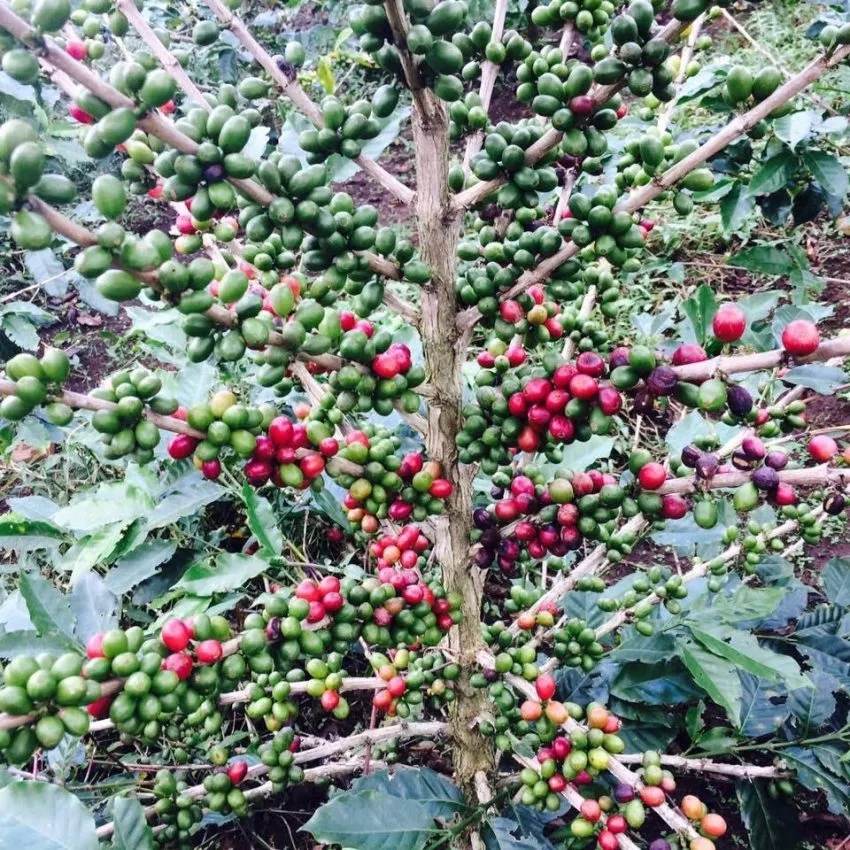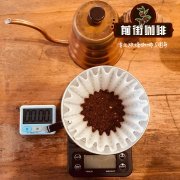Philippine Coffee: seeking Development in the double barriers of abnormal Climate and cheap imported Coffee

Professional coffee knowledge exchange more coffee bean information please follow the coffee workshop (Wechat official account cafe_style)
The Philippines is a coffee producer. The country's different topography and climate make it suitable not only for growing Robusta, but also for Arabica, Liberia and Excelsa.
But in recent years, the Philippines has not produced enough to support its coffee consumption. The extreme climate and rapid urbanization have had a great impact on the coffee industry.
Fortunately, everything is changing. With the collaboration and improvement of infrastructure, the coffee industry in the Philippines is rejuvenating, and boutique coffee is becoming more and more familiar. Today let's take a closer look at Filipino coffee.

Sylvester Dansamont, the 2016 and 2017 Philippine National Barista Champion, competed at the World Barista Championships in Seoul, South Korea. Photo Credit: Jake Olson at the World Barista Championship
A Brief History of Philippine Coffee
The Philippines has been a coffee producer since the mid-18th century. When coffee leaf rust hit Brazil, parts of Africa and Java in the 1880s, the country became the world's largest coffee producer. But leaf rust also spread to the Philippines, where coffee production has never fully recovered since.
In 1960, the Philippine government passed a law banning coffee imports. After that, the Philippines produced enough coffee for domestic consumption and exports until the collapse of the International Coffee Agreement in 1989.
The new trade regime later eliminated import quotas, and the Philippines now relies on coffee from Vietnam and Indonesia because imported coffee is cheaper than homegrown coffee.

The roasted local coffee beans are cooling. Photo Source: NeilSoque
The Philippines consists of more than 7000 islands. In this archipelago, the microclimate and conditions change greatly. This makes the country suitable for growing a wide range of coffee varieties and provides ample opportunities for boutique coffee.
But the islands are constantly hit by typhoons, including the district of Cordillera and the traditional coffee-growing areas of Karabazon. The combined effects of the global economy and climate change have created obstacles to coffee production in the Philippines.

Coffee cherries grow on a coffee tree. Photo Source: Joefel Manlod
Dependence on imported coffee
These factors help explain why the emerging boutique coffee market in the Philippines can only rely on imported beans. For the past three years, winners of the Philippine National barista Championships (PNBC) have used beans from Latin America.
2018 is the first year of the Philippine Coronation Cooking Competition champion-Jaycee Galera uses natural sun native species from Ethiopia's Locke Mountain Reserve.
Maybe it won't always be like this. Despite obstacles to growing and processing boutique coffee in the Philippines, the industry is also growing.

Dried sun-dried coffee on an elevated bed of the Balutakay Coffee Farmers Association of the Philippines. Photo Source: J oefel Manlod
Obstacles to Fine Coffee in the Philippines
The low cost of imported coffee from Vietnam and Indonesia is one of the biggest obstacles to the overall growth of the Philippine coffee industry.
Silvester Dan Samonte is a two-time Philippine national barista champion and coffee director of La Union Cafe. "compared with other global coffee growing areas, the price of local coffee in the Philippines is too high, making it more expensive for foreign investment and scale production of quality coffee," he told me. "
But quality is also a factor. Sylvester says many Filipino coffees are flawed and have low traceability.
"imported coffee is usually cheaper, more reliable and tastier than local coffee. Coffee in the Philippines needs to be cultivated, and most small coffee roasters don't have a business model, "he said.

Joefel Manlod baked coffee beans. Photo Source: PurgeCoffee Roaster
Better infrastructure is needed.
Although producers have good agricultural infrastructure and access to information, the overall quality of locally produced coffee is directly affected by access to resources.
Thomas Sproten is the owner of Bacolod's CoffeeCulture Roastery. Unlike many other coffee-producing countries, the Philippines lacks the infrastructure for coffee processing, warehousing and trade. Many cases are solved by farmers themselves. "
Joefel Manlod is an experienced coffee competitor and the boss of PurgeCoffee Roaster in Davao. He told me that Filipino coffee roasters choose to use coffee beans from Ethiopia, Colombia and Panama, and usually ignore local coffee varieties.
"due to improper farm level and processing, as well as imperfect grading system, local coffee will be criticized as unprofessional," he said.

Thomas Sproten makes coffee at CoffeeCulture Roastery Cafe. Photo Source: Coffee Culture Roastery
Sylvester told me that there was no real incentive for farmers to improve the quality of their coffee beans. "getting high scores on quality or cup tests will not bring more benefits to farmers," he said. Farmers can already sell raw beans for $5 to $10 per kilogram. Why try to improve the quality? "
"basically, farmers have to provide their coffee for evaluation. If the coffee is flawless and has some good qualities, it can get a professional grade, "he said."

A cafe in the Philippines is holding a cup test. Photo Source: Neil Soque
But not all of this is negative. Sylvester also told me that he had sampled local coffee beans and that the problem was to maintain consistent production quality.
"the best I've ever tested are some carefully selected coffee beans from Bukidnon, an Ephemera businessman. Generally speaking, they produce some of the most thoughtful and delicious coffee.
"but because coffee trees are inconsistent with the communities they work with, the ability to create scale and repetitive quality is low. Creating a sustainable coffee system in the most remote parts of the country is a challenge. "

A coffee tree in Kapatagan, Davao del Sur. Photo: Gladys Baylon
Revitalize the coffee industry
But things are slowly changing. In March 2017, the Philippine Coffee Industry Roadmap 2017-2022 was launched to increase domestic coffee production in the Philippines.
"there has been an increase in recent activities to promote the quality of local coffee raw beans," Joefel said.
"non-governmental organizations, government agencies and local micro-bakers are all committed to solving [quality] problems."
An important first step is how to make coffee cultivation a more economically attractive industry for Filipinos in an environment where imported coffee is cheaper. One enterprise committed to achieving this goal is the Kape't Buhay project, which is a partner of government agencies and private organizations. It provides guidance to farmers and encourages them to become entrepreneurs.
Similarly, the Philippine Coffee Commission (PCB) is a private organization that provides technical assistance and credit to coffee growers. It promotes coffee through coffee shop seminars, trade shows, farm tours and the annual coffee festival.

Participants attended intensive coffee training courses for farmers in mountain areas. Matutum, Mindanao. Photo: Purge Coffee Roaster
How to improve the coffee industry in the Philippines
Joefel told me that he thought there was room for improvement in collaboration and communication. "Local roasters should display and produce competitive high-quality roasted coffee to support the hard work of local farmers," he said.
"Local bakers must work with farmers to share new information and trends to improve the quality of picking and processing."

A coffee tree full of coffee cherries in del sur, Davao, in Kapatagan. Photo Source: Gladys Baylon
Sylvester lists what he thinks Filipino specialty coffee needs to do to succeed.
"[we need] the cooperation of the whole industry to pay for the true value of farmers growing coffee," he said.
"[we need] to create processing centers for farmers to use or sell. Find the best varieties to match the different microclimates of the entire archipelago. And is committed to pushing the industry beyond commercial coffee and simple coffee games. "

Silvester Dan Samonte will pull flowers at the World baristas Championships in Seoul, South Korea in 2017. Photo: Jake Olson participates in the World Barista Championships
The rise of Philippine specialty coffee
Despite many obstacles, the Philippines is still producing boutique coffee. Thomas told me that he had brought out some impressive local boutique beans.
"some of the flavor characteristics are similar to those of East African coffee, and most of them inevitably have the characteristics of & # 39; Asian beans & # 39;," he said.
"maybe that's why we didn't find too much Filipino coffee in the game. Just like in international competitions, competitors must use Rosa to impress the judges to have a chance to win, and the Philippines seems to follow this trend. "

Espresso from Cebu Cafe. Photo Source: Neil Soque
"Filipinos like the taste of our own coffee," Sylvester told me. It's in our blood. "
But he also said that "boutique coffee will struggle with most Filipinos living in this country because we are looking for bold flavors rather than the subtleties of boutique coffee." However, Filipinos cultivate some of the best coffee professionals with an optimistic and positive attitude. "

Coffee trees in Kapatagan, Davao del Sur. Photo Source: Gladys Baylon
Specialty baking and coffee shops
Yolk-coffee and breakfast opened in Cebu in 2015. This specialty cafe was originally purchased from Dutch Colony Coffee Co in Singapore. Coffee beans. But now it mainly uses beans from local baked goods. It holds regular events to encourage customers to learn about specialty coffee and try new profiles.
Joefel's Purge Coffee Roaster has been open since 2017. The history of Thomas & # 39 investors sCoffee Culture Roastery can be traced back to 2016. Both bakers are looking for high-quality local beans.
These are just individual examples of the third wave of boutique coffee in the Philippines. But they show that Filipinos are increasingly willing to try boutique coffee, while economics can work for local baking.

Thomas conducts public training at Yolk Coffee & Breakfast in Cebu City. Photo by Kevin Israel Fortu
Production and processing of specialty coffee
Kalsada is a Manila based bakery specializing in Philippine specialty coffee. They support Filipino coffee producers and help them bring coffee to market. They have partnered with Yave, a blockchain platform provider, to track their coffee traceability.
The company currently sells coffee beans from BELIS in the Cordillera Mountains, washed, honeyed, and solarized. By building two processing plants here, they enabled locals to process their signature flavours of tin card and bourbon coffee.
Philippine coffee producers may not be able to keep cheap imports from Indonesia and Vietnam down. But the right infrastructure investments enable some to make the most of their unique environment and produce fine coffee that can be sold at a premium.

Kalita Wave is used to make coffee in a cafe in the Philippines. Photo Source: NeilSoque
The Future of Philippine Coffee
So what does this mean for the coffee industry in the Philippines?
The boutique coffee market here is very young and has great potential. For Filipino professionals, considering the use of locally grown and roasted coffee beans in the competition, there are many areas that need to be improved.
There is room for improvement in infrastructure and quality, and farms in the Philippines are also facing the effects of climate change. But there are clear signs that the industry is booming with the support of professional organizations and the efforts of professional entrepreneurs.

Philippine honey-treated coffee is dried on an elevated bed of the Balutakay Coffee Farmers Association. Photo Source: Joefel Manlod
"Philippine coffee is like a ticking time bomb, waiting for the perfect time and moment to work with the right group of people," Joefel said.
"the Philippines is one of the last boundaries for the cultivation, production and service of boutique coffee," Sylvester told me. Our story as a boutique coffee power has only just begun. "
So pay attention to the World Barista Championships and other competitions. Maybe we will see Filipino players show up with coffee beans grown and baked in their own country.
Article translated from: www.perfectdailygrind.com
Important Notice :
前街咖啡 FrontStreet Coffee has moved to new addredd:
FrontStreet Coffee Address: 315,Donghua East Road,GuangZhou
Tel:020 38364473
- Prev

The cooking parameters of the bean and strawberry filter cup of the sweet orange manor in Honduras will make the flavor sweeter.
Professional coffee knowledge exchange more coffee bean information please follow the coffee workshop (Wechat official account cafe_style) Akira strawberry filter cup. Recently got fired because of the 2018 World Cooking Competition. Liu Bangyu uses strawberry filter cups in the competition. Won the Taiwan District Champion. Therefore, the filter cup became famous! Strawberry cup flow rate. Velocity of conical cup between conical and trapezoidal cups
- Next

Introduction of Red Cherry Project Yega Chuefei Flavor treatment method introduction of Red Cherry Project
Professional coffee knowledge exchange more coffee bean information Please follow the Coffee Workshop (official Wechat account cafe_style) operation Cherrie Red Red Cherry Project (ORC) is a project to improve the quality of small-scale farms, the main aim is to encourage soybean farmers and surprise roasters. Trabocca, the largest coffee bean seller in the Netherlands, invited all Ethiopian farms before the harvest season.
Related
- Does Rose Summer choose Blue, Green or Red? Detailed explanation of Rose Summer Coffee plots and Classification in Panamanian Jade Manor
- What is the difference between the origin, producing area, processing plant, cooperative and manor of coffee beans?
- How fine does the espresso powder fit? how to grind the espresso?
- Sca coffee roasting degree color card coffee roasting degree 8 roasting color values what do you mean?
- The practice of lattes: how to make lattes at home
- Introduction to Indonesian Fine Coffee beans-- Java Coffee producing area of Indonesian Arabica Coffee
- How much will the flavor of light and medium roasted rose summer be expressed? What baking level is rose summer suitable for?
- Introduction to the characteristics of washing, sun-drying or wet-planing coffee commonly used in Mantenin, Indonesia
- Price characteristics of Arabica Coffee Bean Starbucks introduction to Manning Coffee Bean Taste producing area Variety Manor
- What is the authentic Yega flavor? What are the flavor characteristics of the really excellent Yejasuffi coffee beans?

